News
What we’ve learnt from the first week of Super 12 matches
 WEEK 1 ANALYSIS
WEEK 1 ANALYSISAnchor supremacy, the value of wickets, the importance of match-ups and more
10 matches into the Super 12 stage, this 2021 edition of the T20 World Cup is starting to take shape, and is also slowly starting to catch fire. No one quite knew what to expect heading into the second round but now, almost a week in, there are evidently clear patterns that are starting to emerge.
With the stakes getting higher, we look at some key observations from the first set of the Super 12 matches in which there were quite a few valuable takeaways.
Damage-control in powerplay is imperative
In the lead-up to the tournament, a multitude of players stressed on the importance of ‘winning the powerplay’. The reason is simple: on slow and low wickets, batting gets tougher with the time, and hence it is imperative for teams to maximize the first six overs. Not only because there are only two fielders out in the deep, but also due to the ball being hard and new.
But what we’ve seen in this first week of the Super 12 games is that you can even afford to go slow; what you cannot do though, is lose wickets in a cluster upfront.
So far in the Super 12 stage of the T20 World Cup, 7 times teams have lost 3 or more wickets inside the powerplay. Remarkably, on 6 occasions those sides have gone on to lose the game. The only exception has been England, who, mind you, were chasing a mere 56.
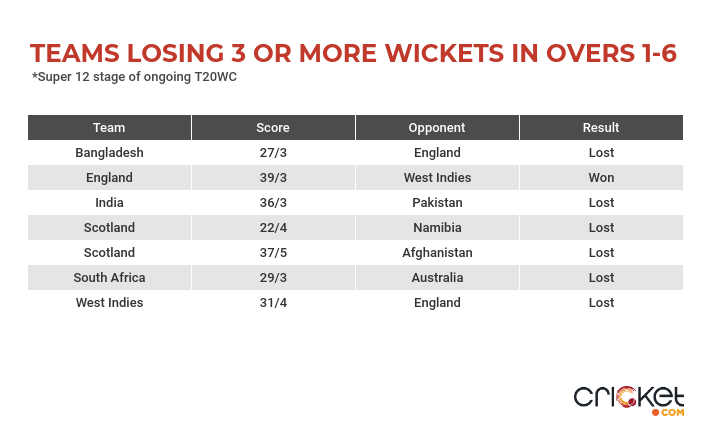
Whilst batting first, teams that have lost 2 or more wickets inside the powerplay have lost 100% of the time.
Conserving wickets is no guarantee of a win, but it will, at the very least, ensure better totals are put up. Thus far in the Super 12 stage, whilst batting first, teams that have lost 2 or more wickets inside the powerplay have posted an average total of 111.4, compared to the 158.4 posted by teams that have lost 1 or fewer wickets inside the first six.
This brings us to our second point.
Batting first has been hell because teams have struggled to pace their innings
As of October 29 (post the AUS vs SL game), quite remarkably Afghanistan have been the only side to defend a total successfully. Of the ten Super 12 games played, 9 have been won by the team chasing.
Sure, toss and dew have played a part, but the primary reason for this has been teams’ inability to pace their innings whilst batting first. No one has been able to figure out how to construct their innings.
Some teams have gone too hard up-front and lost their head in the process, while others have left it too late. In certain cases, sides have motored along in third gear for the entirety of their innings. Ultimately though, regardless of the path, teams batting first have always ended up with below-par scores.
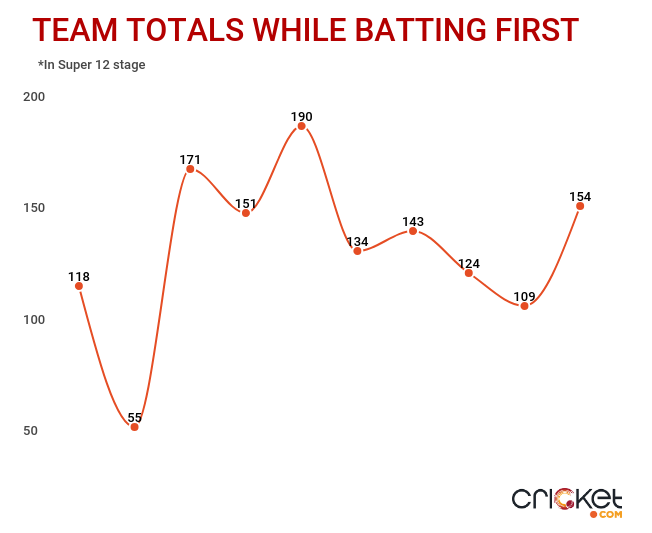
We saw this in the UAE edition of the IPL, too. Of the 31 matches in the second half of the competition, a staggering 21 were won by teams that chased. There was the odd breathtaking chase but, in general, teams batting first struggled to post par and above-par scores.
With dew expected to play a more significant part as this World Cup progresses, expect this phenomenon to continue. Barring Afghanistan, who have a bat-first-and-choke-with-spin template, expect sides to continue chasing. And, more often than not, expect sides to be perpetually confused when they bat first.
Anchors do have a big role to play
There is no question that dynamic, x-factor batters will ultimately win games. But so far in this Super 12 stage, what we’ve seen is that, on these sluggish wickets, anchors will have a significant role to play. How they hold the innings together and set the game up for the big-hitters will be key.
We’ve already seen the likes of Kohli, Rizwan, Babar, Smith and Van der Dussen play vital hands. And as the wickets get more tired, their value will only increase exponentially.
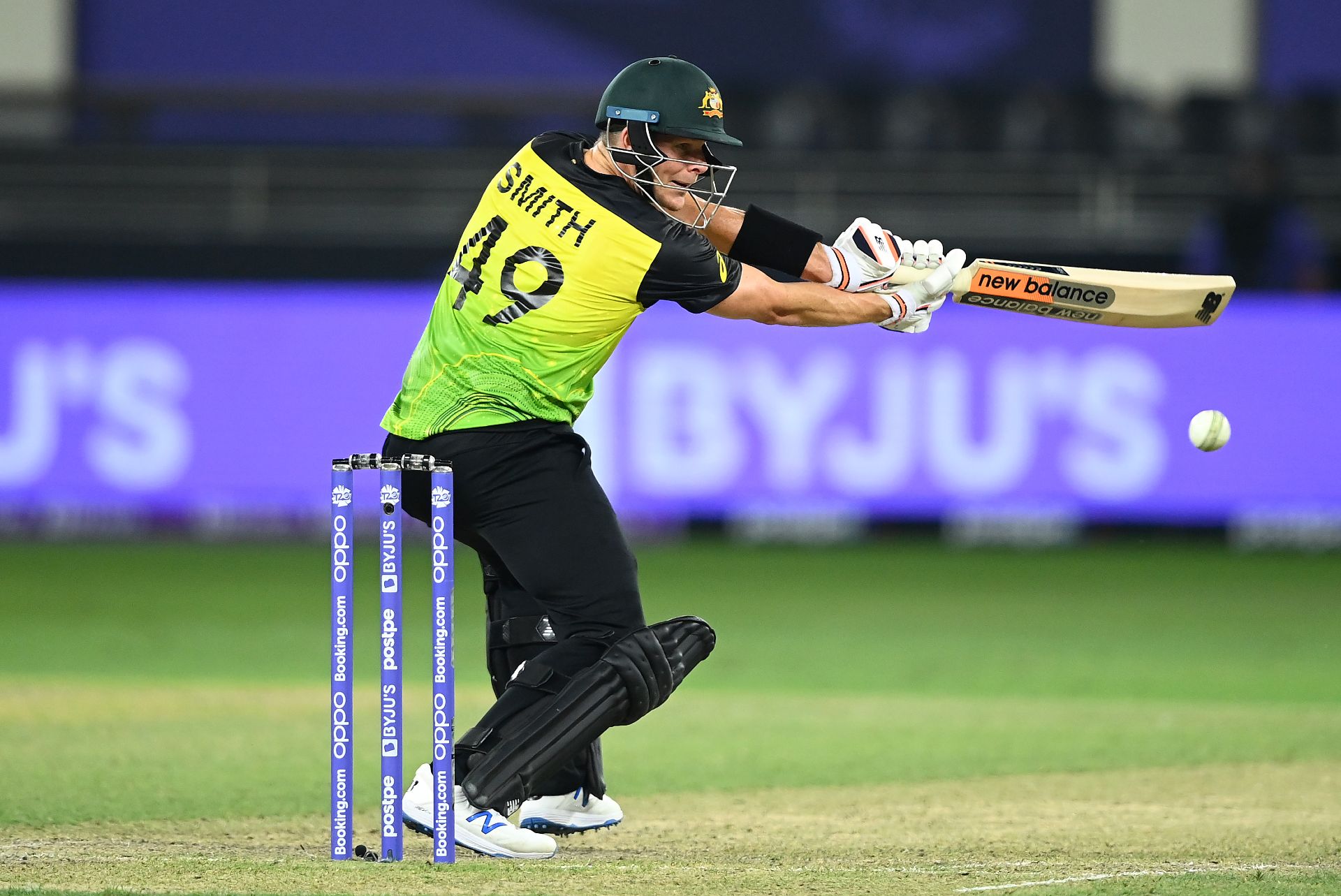
It can be said, however, that on these evidently slow wickets, the perfect recipe of success is for anchors and x-factors to compliment each other like Burger and Fries.
Kohli-Pant, Malik-Asif Ali, Smith-Stoinis and Nissanka-Asalanka have all shown how effectively such a combo could work.
Having the two-in-one kind batters like Maxwell, Warner, Gurbaz and Markram is always a bonus, but hunting in pairs that possess contrasting individuals have thus far proved to be the most effective way to break down bowling sides. It is little wonder that a team like West Indies, that possesses no natural anchor, has therefore struggled.
Are you a seamer? Hit the good length
Pace or no pace; seam-up or cross-seam; conventional ball or slower ball; it doesn’t matter. If you’re a seamer playing in this T20 World Cup, the wisest thing you can do is hit the good length as frequently as possible.
And the numbers don’t lie. So far in this Super 12 stage, batters have struggled to put balls pitched on a good length. The 6m-8m mark has almost been a cheat code for the bowlers.
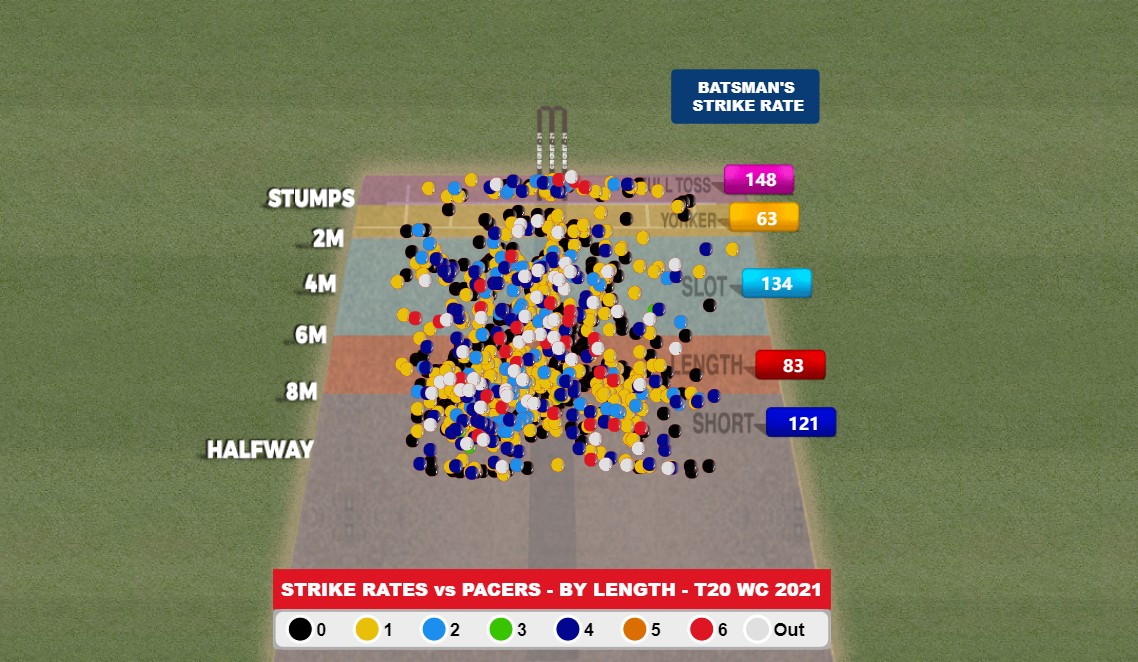
The numbers above were collated prior to the AUS vs SL game
Why is this length so hard to put away? Chris Woakes, on Wednesday, after England restricted Bangladesh to 124, explained.
“The wickets are a bit two paced and a bit tired, like you saw in the IPL. If you hit the length hard, you get that bit of variable bounce,” Woakes said.
And as mentioned, it has worked for all kinds of bowlers. From the likes of Tymal Mills, Anrich Nortje and Haris Rauf, who have raw pace to go along with effective slower balls, to the likes of Chris Woakes and Josh Hazlewood, who solely rely on line and length, and to the likes of David Wiese and Jimmy Neesham, whose go-to balls are off-cutters, batters have found all types of seamers difficult to put away on sluggish wickets that have tended to consistently bounce low.
It is only when the bowlers have erred with their lengths, particularly going too full, that the batters have been able to take advantage.
With the wickets expected to get a bit more tired as the competition progresses, there is simply no reason for the seamers to move away from this plan; the batters will find life difficult, even if they know what’s coming.
Managing match-ups and ground dimensions is key
In Cricket, the term ‘match-up’ has probably been used more this year than it has been in all previous years combined. Heading into the tournament, so much was being made of match-ups.
And in the first round of Super 12 games, we learnt why. For the sides that managed match-ups efficiently and effectively had plenty of success.
On the very first day of the Super 12 stage, we saw England dish-out a match-up masterclass. With 3 of West Indies’ top four batters being left-handers, Eoin Morgan bowled four straight overs of Moeen Ali up-front and reaped benefits for the same, as the offie returned figures of 2/17.
But not just that, Morgan also held back the leg-spin of Rashid for the right-handers, while he unleashed Tymal Mills against Pooran, a batter who struggles against raw pace. It was data being put to use to perfection.
A day later, it was Sri Lanka’s turn to fly high, but this time with the bat. Bangladesh fielded two left-arm spinners in their XI, but the Lankans nullified that threat through southpaw Charith Asalanka, who struck 33 runs off the 15 balls he faced of Shakib and Nasum Ahmed.
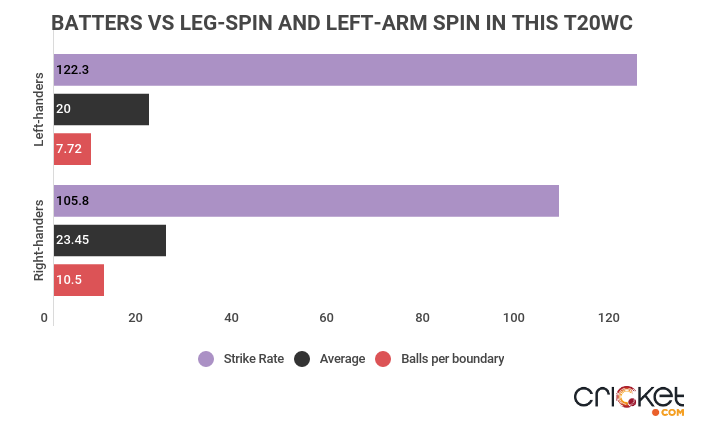
The numbers above were collated prior to the AUS vs SL game
In the same game we also saw that match-ups are not as simple as ‘bowl off-spinners to left-handers’ as Bangladesh paid the price for preferring the part-time off-spin of Mahmudullah and Afif Hossain, both of whom were dismantled by the Lankan left-hand batters.
In the New Zealand vs Pakistan game meanwhile, both sides promoted attacking left-hand batters (Neesham and Imad Wasim respectively) to nullify the threat of left-hand spinners and leg-spinners. Neither move came off, but it was a sign of both sides thinking proactively.
In fact, Pakistan out-thought the Kiwis in this encounter as they brought in off-spinner Hafeez as soon as Neesham was promoted. The result? You guessed it: Hafeez dismissed the southpaw.
As the tournament progresses, identifying and acing match-ups could very well be the telling factor.
Something equally important, which falls under the ‘nous’ category, is also how teams manage the shorter/longer boundaries.
Due to a variety of different wickets being used, the square boundary dimensions are not even, with one side being more distant to the pitch compared to the other. Hence, field setting and bowling plans hold that much more significance.
Thus far, South Africa and England are two sides that have been adept at utilizing the dimensions to their advantage.
Both match-ups and management of ground dimensions are certainly things that will be a very good test of captaincy.